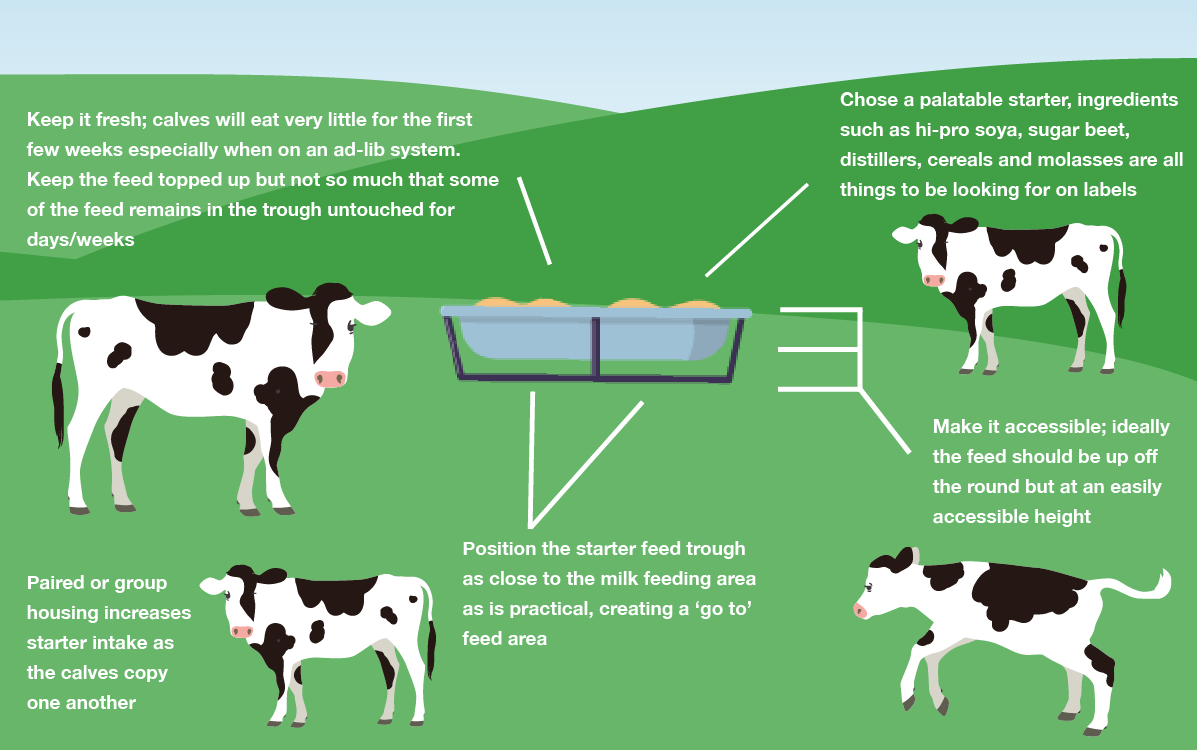We expect our calves to be able to cope and adapt to shifts in their nutrition throughout the pre-weaning phase, the first being from colostrum to whole milk/milk replacer and the last being from liquid to solid feed. Weaning is without doubt one of the biggest transformations the Gastrointestinal tract (GIT) will undergo and therefore understanding when and how we can best manage this juncture to avoid growth checks and impaired GIT health is important to the productivity of our calves.
How To Manage the Weaning Process
We have previously based weaning on the following parameters – starter feed consumption and weighing twice their birth weight but what do these two measurements represent and with higher planes of nutrition coming into play are they enough to ensure a smooth transition while maintaining elevated growth rates.
Rumen Development
The success of a weaning transition is governed by rumen development. If the rumen is not sophisticated enough to carry out its primary functions by total milk removal our calves will suffer a growth check and partially digested feed may be entering the lower gut potentially leading to hindgut acidosis or a dark scour.
The establishment of digestive activity in the rumen requires water, feed and microbial activity. Microbes begin populating the rumen at birth from within calving fluids, colostrum and the skin and saliva of the cow. These initial microbes create an anaerobic environment for further microbes to colonise.
Read more: Optimal Colostrum Quality and Quantity - It Comes From the Mother!
Starter Feeds
Offering starter feed from week one encourages the production of Volatile Fatty Acids (VFAs). VFA production in the rumen increases from day 15 – this is when we expect starter feed intake to begin, albeit in small quantities. 75 – 90% of the butyrate produced in the rumen is metabolised by the rumen wall for the stimulation of Papillae development. The larger the Villi the greater the area for VFA absorption post-weaning. Offering straw as roughage builds the muscularity and capacity of the rumen, the rumen will eventually increase from 30 – 70% of the entire GIT.
Read more: Calf Starter- what’s important?
Offering Water
Drinking water should be offered from birth, both the microbial and mechanical activity in the rumen require a liquid environment. The water portion of the milk is not sufficient, as this bypasses the rumen to go directly into the Abomasum.
When Should You Start Weaning?
When discussing early weaning we should be thinking about eight weeks, not six. In the following study, calves were fed the same amount of MR for either five or seven weeks then weaned using the same step-down method over one week to be weaned at either six or eight. This table highlights the differences seen in Average Daily Gains (ADG).
| 6 weeks wean group | 8 weeks wean group | |
| ADG during weaning week (kg) | 0.34 | 0.79 |
| ADG in week after weaning (kg) | 0.35 | 1.05 |
| Average weight at 10 weeks (kg) | 91 | 99.9 |
The loss in growth and internal development as a result of weaning at six weeks is unlikely to ever be recovered. Delaying the age of weaning to 10 or 12 weeks lessens the reduction in daily live weight gain and leads to a more gradual increase in the rumen’s fermentation activity.
The step down of milk should be done gradually over more than seven days in order to give the calf’s GIT time to adapt to a solely solid diet. Calves fed elevated levels of milk will require a longer weaning period as their starter intakes preweaning are likely to be less. An initial drop in milk of 25% will kick off their starter intakes.
How do Manually Fed Calves Compare?
| Milk Replacer (g) | Starter Feed intake to wean (g) |
|
900 |
1,800 |
| 1,050 | 2,100 |
| 1,200 | 2,400 |
| Whole Milk (L) | Starter Feed intake to wean (g) |
| 6 | 1,500 |
| 7 | 1,750 |
| 8 | 2,00 |
Manually fed calves should still be fed twice daily throughout the onset of weaning until starter intakes have increased. Removing a feed completely is more stressful than having two slightly smaller feeds.
In order to avoid a reduction in ADG a calf should be consuming twice the amount of starter as dry matter coming from the milk portion of their diet at the peak of their feed curve. The tables below relate to the amount of starter the calf should be consuming for three consecutive days before milk can be removed completely at the end of the milk step down phase.
Top Tips To Encourage Starter Intakes











